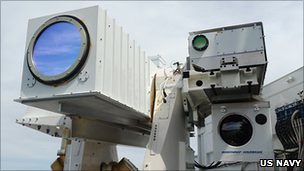
A US Naval ship laser which is to be utilized against Somalians off the coast of the Horn of Africa nation. The US and other European states have dispatched flotillas of warships in the Gulf of Aden., a photo by Pan-African News Wire File Photos on Flickr.
US navy turns lasers on Somali pirates
The US navy has successfully tested a solid-state high-energy laser that it plans to use on Somali pirates.
Source: The Daily Telegraph, UK
A SHIP-based laser tested by the US navy's research arm could put the heat on Somali pirates.
The Navy for the first time last week successfully tested a solid-state high-energy laser from a ship.
The beam, which was aimed at a boat moving through turbulent Pacific Ocean waters, set the target's engine on fire.
The Office of Naval Research says the laser travelled over "miles, not yards".
For now, the test is a proof of concept, and it's not yet known when it might be deployed as a weapon.
The baseball-sized laser beam, though, could be used to stop small crafts from approaching naval ships.
It could also target pirates.
"You can use the laser to ward off an attack, or you can dial it down to a non-lethal level where it basically becomes a very bright light so they know they are being targeted," Michael Deitchman, the director of air warfare and weapons at the Office of Naval Research, said on Wednesday.
Deitchman said the laser provides two benefits not seen in other military weapons. The laser is precise, unlike bullets that can ricochet and hit unintended targets, and the laser's strength can be dialed down from a lethal level to a nuisance level.
Graeme Gibbon-Brooks, the head of Dryad Maritime Intelligence, said the test was "remarkable" for how the Navy was able to concentrate the beam over such a long distance at sea, and given how the boat was being tossed about in rough water.
"Hats off to the US Navy because that is very, very impressive," he said. "It was pitching and rolling and yet they got this very fine beam to focus on one part of an engine casing. That they managed to keep the energy in one place is remarkable."
Somali pirates attacks have become increasingly violent in recent months. Pirate assaults typically involve multiple skiffs zooming in on a target. The pirates often carry and fire AK-47 assault rifles and rocket-propelled grenades at targets.
Some cargo ships now carry private security guards to defend against pirates. They also can use such defensive measures as water cannons and sound blasters. But those measures may not be enough to overcome an armed attack.
Gibbon-Brooks said the new laser "absolutely" could be deployed against pirates but says a sniper rifle could work just as well. He suspects the Navy has bigger hopes for its sea-based laser. The Navy released a video of the test on YouTube.
It's been viewed more than 600,000 times.
"It's a very, very interesting moment for naval warfare in that we have a whole new genre of weapons," he said.
"It's certainly a remarkable step forward. The ability to apply more power in a burst or the ability to manipulate that power is really where I see this going," he said. "I think if you watch the video and think that's what they intend to do to Somali pirates in a year, you don't understand what's being set out in front of them. It could be used in any type of naval warfare."
The laser test was carried out by the Navy and Northrop Grumman as part of a $US98 million ($A93.5 million) contract.
The Office of Naval Research's big project is a megawatt-level electron laser that could be used to defend naval ships against supersonic and ballistic missiles, said Deitchman. The recent laser test helps the Navy move in that direction.
"It demonstrated once and for all that we could get material damage effects with a laser at sea, and it really gives us confidence to proceed on with directed energy systems," Deitchman said.
No comments:
Post a Comment